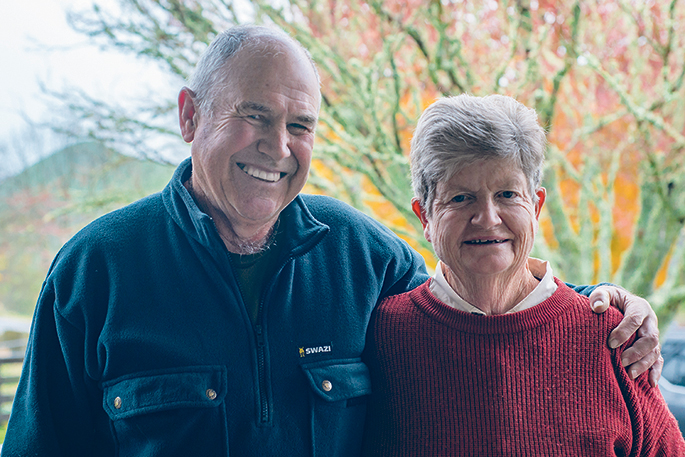Bill and Sue Garland have farmed their 420ha at Rahiri Farm, near Roto O Rangi, Cambridge, for nearly 50 years. The couple have put considerable resources – financial and physical – into conservation and preservation of their land. And they’re very willing to share their experiences – both good and bad – with others wishing to put similar farm plans into practice.
The Garlands hosted Environment Minister David Parker and Agriculture Minister Damien to launch the national Good Farming Practice Action Plan for Water Quality on their farm in June.
The action plan is a national set of good practice principles and actions that horticulture and farming leaders, regional councils and government have agreed on to improve NZ’s freshwater quality. The aim is for every farmer and grower to have a farm environment plan to help them identify environmental risks and set out ways to manage them.
Bill welcomes the plan’s vision. “My view is it’s not just water quality that will benefit. By having a farm plan you look at areas to be cultivated, pastures that can be improved and water reticulation. “Fencing and planting also means shelter and shade for stock, improved stock movement, increased productivity, habitat for birds, and offsetting carbon emissions.”
The Garlands bought 120ha with its original ‘rehab’ house in 1969 and run beef and sheep. They’ve added to the land, resulting in 420ha over six titles. The farm has a long history, with evidence of early Maori settlement on this rolling hill country of fertile Maeroa ash soils, and the Mangapiko Stream with its numerous tributaries.
“We were both raised on Cambridge farms with English trees,” says Bill. “This farm had very few other than natives, so we planted hundreds early on as we were redesigning the infrastructure of the farm.”
A forestry project was started around 15 years ago. “We had a steep area that was prone to erosion and covered in gorse and other woody weeds,” says Bill.
Wetlands
Calling upon his experience as part of a discussion team at the Whatawhata Hill Country Research Station, Bill modelled his plan on Whatawhata. Fifteen years in, the hillside is planted with Tasmanian blackwood and cyprus, and natives such as kauri, rimu and totara.
Prior to the late-1980s, and de-regulation of the economy, substantial rural government subsidies were available for water and soil conservation work. When these subsidies were removed, the Garlands continued their work using their own money.
Of the 45 wetland areas on the farm, one has specific significance from its Maori past. Five-hundred metres of waterway has been fenced and restored, making a large 1.2ha wetland area that cost around $50,000 to complete. Aware that the flax from this area was used historically for weaving, Bill and Sue had the leaves sampled and confirmation that it was very high quality weaving flax. Sue collected hundreds of seeds from the original plants, and the resulting seedlings are now planted in the area, with further seed collections planned.
“We also planted dozens of rare plants from the Tamahere nursery of gully expert Peter Morris,” says Bill. “To protect it all, we’ve put a QEII covenant on the area, naming it after my aunt and uncle, Nelson and Mariana Garland, who owned the land previously.”
Similar wetland projects throughout the farm have a big commercial benefit. Gullies that were once death traps for stock, and open to erosion, are now fenced off, planted wetlands.
“It’s a balancing act to ensure there’s enough ground vegetation and areas aren’t overplanted,” says Bill. “Getting it right means that water from higher ground loses energy, reducing flooding downstream. Sediment, phosphates and E. coli are filtered out in the wetland area, significantly reducing the amount entering the waterways.”
Suitable stock
Other areas with waterways are unsuitable for fencing off, so they have been left as paddocks and only less destructive sheep graze these areas.
“Matching stock to the type of land is the key to minimising damage and erosion,” says Bill.
Bill credits his father’s knowledge of the farm with some decisions that have been made over developing scrub areas at the back while it was still owned by his parents.
“He told us to leave one steep, unstable area as bush,” says Bill, “He said that good water came out of the area, and one day water would be important. He was ahead of his time in his thinking. This area also has a QEII covenant.”
The property shares 8km of the pest-proof fence surrounding Sanctuary Mountain Maungatautari, and 30ha of the farm is inside the fence and under QEII covenant. Sympathetic with the Sanctuary Mountain environmental project, Bill and Sue allow access through their land, and have planted acres of native plants that attract and feed native birds that leave the fenced area as numbers grow inside.
Standalone business
The money for all the environmental work depends on the farm being a standalone business, extracting as much commercial gain from the land as possible. Rahiri farm supplies beef to the American hamburger market, and lamb to Wholefoods, a top-end American supermarket. The latter enterprise requires adhering to stringent rules and standards around how the lambs are reared, but this only adds to Bill and Sue’s commitment to excellent animal welfare and environmental practices.
Permission is frequently given to photographers, film crews, researchers etc to access the farm, so others can enjoy and study the beautiful environment the Garlands have created.
“As well as protecting the environment, we want to protect the values of the life we experienced as children on the farm,” says Bill. “Sharing what the farm has to offer gives us great pleasure.”



0 Comments
Leave a Comment